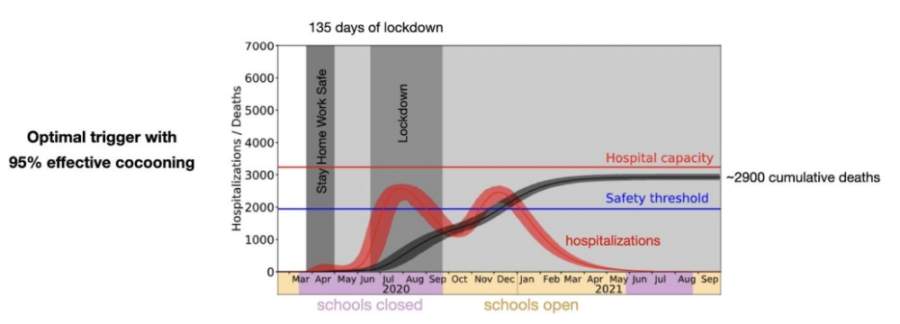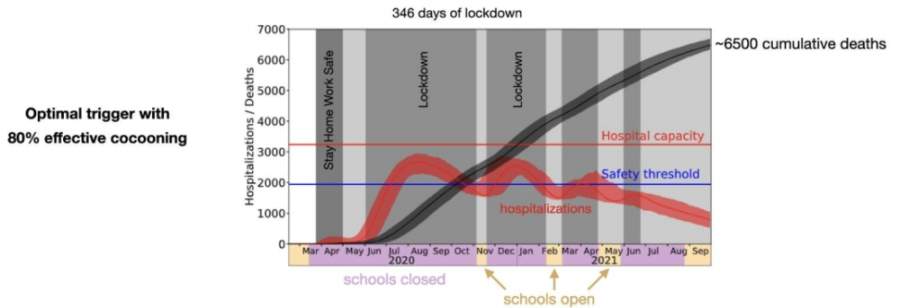Gov. Abbott said the statewide shelter-in-place order will expire April 30. Businesses, including restaurants, malls and movie theaters, can legally reopen May 1 if they limit their facilities to 25% capacity. Abbott further said that if after two weeks of monitoring, the community does not see a dramatic increase, the state will enter phase two and begin letting businesses operate at 50% capacity.
Lauren Meyers, an integrative biology professor at the University of Texas at Austin who has led the coronavirus modeling on which city officials have relied heavily, said that Abbott’s decision is not in the best interest of community health. She also said “unequivocally” that two weeks is not enough time to monitor the success of any policy decisions related to the virus.
“If you say our goal is to minimize deaths and minimize hospitalizations, the answer will be ... just [to] stay fully locked down or as locked down as you can for the longest period of time,” Meyers told Austin City Council.
Austin Mayor Steve Adler said the expiration of statewide shelter-in-place orders and reopening of some businesses will result in more infections “by definition” since more person-to-person interactions will occur.
“I’m concerned, personally, that the governor has done this a little bit too early. I am concerned that he may have gone too far,” Adler said. “I am really concerned when the governor suggests that we'll know in a couple of weeks how the new policies work because we won't. If there's one thing I've learned, it's that this is a trailing thing, and it will be probably four weeks until [we] know.”
Adler said the “overwhelming impression” he has gotten from most Texas mayors is that they wish Abbott had waited another few weeks to make this call.
Meyers said postponing the reopening by a couple weeks or even a couple months would not have reduced the number of hospitalizations or deaths; however, it would have given communities more time to prepare.
“What waiting does is buys us precious time to ramp up testing capacity [and] to ensure we have measures in place to cocoon our vulnerable population, including protecting residents of long-term care facilities, like nursing homes,” Meyers said. “There are so many things we can do to protect our vulnerable populations. We can’t do all those things by May 1.”
Models project various scenarios after a May 1 reopening According to models Meyers produced for City Council, maintaining an indefinite lockdown—Meyers' recommended course to limit the number of deaths and hospitalizations—could result in hospitalizations never peaking above current levels.
 Deaths, the models showed, would peak at 80. As of April 28, Austin-Travis County has 71 hospitalizations and 42 deaths related to the coronavirus.
Deaths, the models showed, would peak at 80. As of April 28, Austin-Travis County has 71 hospitalizations and 42 deaths related to the coronavirus.Conversely, relaxing the stay-at-home measures May 1 could result in an overwhelming surge of hospitalizations and deaths.
 Meyers’ models given this earlier opening show hospitalizations peaking sharply from late July to early August at roughly 6,000—hospital system capacity is just over 3,000; the models then show hospitalizations falling off in late August before almost completely fizzling out by year’s end. The same models show deaths peaking between October and November at 2,900.
Meyers’ models given this earlier opening show hospitalizations peaking sharply from late July to early August at roughly 6,000—hospital system capacity is just over 3,000; the models then show hospitalizations falling off in late August before almost completely fizzling out by year’s end. The same models show deaths peaking between October and November at 2,900.Meyers said that in that scenario, even though virus would fizzle out by the end of the year, it would cause a “catastrophic” overwhelming of the health care system.
Other models from Meyers projected the impact of phased-in lockdowns and critical measures to protect vulnerable senior citizens and high-risk youth. Meyers used the term “cocooning” to describe protecting the community’s most vulnerable from person-to-person interactions amid a wider reopening of society.
The models showed at 95% effective cocooning, another lockdown could be necessary between mid-June and mid-September. Hospitalizations would peak at just under 3,000 in early August and would not overwhelm
 the hospital system. Under these circumstances, the models predicted a similar peak in hospitalizations by mid-December before beginning a permanent downward trend toward a complete fizzling-out by June 2021. Deaths would still reach 2,900 but would not reach that number until roughly March 2021.
the hospital system. Under these circumstances, the models predicted a similar peak in hospitalizations by mid-December before beginning a permanent downward trend toward a complete fizzling-out by June 2021. Deaths would still reach 2,900 but would not reach that number until roughly March 2021.A separate model showing 80% effective cocooning paints a grimmer picture. In that situation, to refrain from overwhelming the health care system,
 another lockdown would be necessary between June and November, followed by a another lockdown from mid-November to mid-January, another lockdown from early March to late April 2021 and a final lockdown in June 2021. This model shows three waves of hospitalizations—early August, January and late April 2021— before slowing down after September 2021; deaths would continually rise through September 2021, peaking at 6,500.
another lockdown would be necessary between June and November, followed by a another lockdown from mid-November to mid-January, another lockdown from early March to late April 2021 and a final lockdown in June 2021. This model shows three waves of hospitalizations—early August, January and late April 2021— before slowing down after September 2021; deaths would continually rise through September 2021, peaking at 6,500.During his April 27 announcement to reopen Texas, Abbott said the decisions were based on scientific data, modeling and recommendations by experts. However, Meyers told City Council April 28 that Gov. Abbott had not seen the UT-Austin models.
The governor’s office did not respond to requests for comment by press time.
‘Not the time to flip on the light switch’
Dr. Clay Johnston, the dean of the University of Texas Dell Medical School, said that although hospitals are not at capacity, receiving coronavirus cases nonetheless places stress on resources.
As far as being prepared for a reopening, Johnston said the region still needs to improve its testing capacity and ability to perform contact tracing, which aims to identify everyone with whom a positive coronavirus patient came in contact. Johnston said more data and reporting is needed at levels beyond what the region has supplied.
Robust testing capacity has long been cited as critical for any successful societal reopening. At 6.6 tests per 1,000 residents, Travis County has been administering tests at a higher rate than any other Texas county over the past six weeks. Late last week, the city debuted its public enrollment program that allows qualified residents to sign up for a free coronavirus test.
The new enrollment program will boost the county’s testing by 2,000 tests per week; however, Dr. Mark Escott, the Austin-Travis County interim health authority, said the area needs 2,000 tests per day.
“As we’re still preparing contact tracing, as we’re still ramping up testing, as we’re working to protect the most vulnerable populations, now is not the time to flip on the light switch,” Escott said April 28.





